Medical Imaging Techniques
Course Details

KTO KARATAY UNIVERSITY
Vocational School of Medical Services
Programme of Medical Imaging Techniques
Course Details
Vocational School of Medical Services
Programme of Medical Imaging Techniques
Course Details

| Course Code | Course Name | Year | Period | Semester | T+A+L | Credit | ECTS |
|---|---|---|---|---|---|---|---|
| 02921008 | Radiation Safety and Radiation Protection | 1 | Spring | 2 | 2+0+0 | 3 | 3 |
| Course Type | Elective |
| Course Cycle | Associate (Short Cycle) (TQF-HE: Level 5 / QF-EHEA: Short Cycle / EQF-LLL: Level 5) |
| Course Language | Turkish |
| Methods and Techniques | - |
| Mode of Delivery | Face to Face |
| Prerequisites | - |
| Coordinator | - |
| Instructor(s) | Lect. Merve ARI |
| Instructor Assistant(s) | - |
Course Instructor(s)
| Name and Surname | Room | E-Mail Address | Internal | Meeting Hours |
|---|---|---|---|---|
| Lect. Merve ARI | B-Z27 | [email protected] | 7356 | Wednesday 10.00-12.00 |
Course Content
Design Characteristics of Radiology Departments, Design Properties of Radiation Rooms, Radiation Nadir @f51, Radiation Doses and Units, Effects of Radiation on Human Body, Effects of Radiation on the Human Body, Late Effects of Radiation, Epidemiological Studies, Basic Principles of Radiation Protection, Conservation of radiation near the patient and the patient, Protection of hospital personnel from radiation, Protection of the radiation from the environment, TAEK Radiation Safety Legislation Radiation Safety Committees Structure, Other Legal Legislation on Radiation Safety, Implementation of Emergency Plans, Application of Emergency Plans
Objectives of the Course
Teaching the protection of personnel and patients from harmful effects of radiation
Contribution of the Course to Field Teaching
| Basic Vocational Courses | X |
| Specialization / Field Courses | X |
| Support Courses | |
| Transferable Skills Courses | |
| Humanities, Communication and Management Skills Courses |
Relationships between Course Learning Outcomes and Program Outcomes
| Relationship Levels | ||||
| Lowest | Low | Medium | High | Highest |
| 1 | 2 | 3 | 4 | 5 |
| # | Program Learning Outcomes | Level |
|---|---|---|
| P1 | Has the knowledge to evaluate and apply shooting positions related to the field of medical imaging techniques, technical infrastructure and physics principles of imaging devices, radiation safety and radiation protection rules, pharmacological structures of contrast agents, side effects and risk factors, and uses applied knowledge. | 5 |
Course Learning Outcomes
| Upon the successful completion of this course, students will be able to: | |||
|---|---|---|---|
| No | Learning Outcomes | Outcome Relationship | Measurement Method ** |
| O1 | Ability to express the necessary theoretical knowledge in imaging processes in the field of medical imaging techniques. | P.1.1 | |
| O2 | Ability to understand the application requirements of imaging processes in the field of medical imaging techniques by associating them with theoretical foundations. | P.1.2 | |
| O3 | Ability to apply theoretical knowledge of imaging processes in the field of medical imaging techniques on the patient. | P.1.3 | |
| O4 | Ability to compare and analyze the application results of different approaches in imaging processes in the field of medical imaging techniques. | P.1.4 | |
| ** Written Exam: 1, Oral Exam: 2, Homework: 3, Lab./Exam: 4, Seminar/Presentation: 5, Term Paper: 6, Application: 7 | |||
Weekly Detailed Course Contents
| Week | Topics |
|---|---|
| 1 | Definition and Properties of Radiation |
| 2 | Definition and Properties of Radiation II, Radiation Doses and Units |
| 3 | The Effects of Ionized Radiation on the Human Body |
| 4 | Early and Late Effects of Radiation |
| 5 | Fundamental Principles in Radiation Protection |
| 6 | Radiation protection of the employee itself, the patient, the patient and the hospital staff |
| 7 | Midterm Exam |
| 8 | Protecting the Environment from Radiation |
| 9 | TAEK Radiation Safety Legislation |
| 10 | Structure of Radiation Safety Committees |
| 11 | Other Legal Legislation on Radiation Safety |
| 12 | Implementation and Implementation of Emergency Plans |
| 13 | Design Features of Radiology Departments |
| 14 | Design of Chambers for Ionizing Radiation |
Textbook or Material
| Resources | Radyasyon Güvenliği ve Radyasyondan Korunma Dersi Ders Notları |
| Temel Radyoloji Tekniği, Prof. Dr. Tamer KAYA |
Evaluation Method and Passing Criteria
| In-Term Studies | Quantity | Percentage |
|---|---|---|
| Attendance | - | - |
| Laboratory | - | - |
| Practice | - | - |
| Field Study | - | - |
| Course Specific Internship (If Any) | - | - |
| Homework | - | - |
| Presentation | - | - |
| Projects | - | - |
| Seminar | - | - |
| Quiz | - | - |
| Listening | - | - |
| Midterms | 1 | 40 (%) |
| Final Exam | 1 | 60 (%) |
| Total | 100 (%) | |
ECTS / Working Load Table
| Quantity | Duration | Total Work Load | |
|---|---|---|---|
| Course Week Number and Time | 14 | 2 | 28 |
| Out-of-Class Study Time (Pre-study, Library, Reinforcement) | 0 | 0 | 0 |
| Midterms | 1 | 27 | 27 |
| Quiz | 0 | 0 | 0 |
| Homework | 0 | 0 | 0 |
| Practice | 0 | 0 | 0 |
| Laboratory | 0 | 0 | 0 |
| Project | 0 | 0 | 0 |
| Workshop | 0 | 0 | 0 |
| Presentation/Seminar Preparation | 0 | 0 | 0 |
| Fieldwork | 0 | 0 | 0 |
| Final Exam | 1 | 35 | 35 |
| Other | 0 | 0 | 0 |
| Total Work Load: | 90 | ||
| Total Work Load / 30 | 3 | ||
| Course ECTS Credits: | 3 | ||
Course - Learning Outcomes Matrix
| Relationship Levels | ||||
| Lowest | Low | Medium | High | Highest |
| 1 | 2 | 3 | 4 | 5 |
| # | Learning Outcomes | P1 |
|---|---|---|
| O1 | Ability to express the necessary theoretical knowledge in imaging processes in the field of medical imaging techniques. | 5 |
| O2 | Ability to understand the application requirements of imaging processes in the field of medical imaging techniques by associating them with theoretical foundations. | 5 |
| O3 | Ability to apply theoretical knowledge of imaging processes in the field of medical imaging techniques on the patient. | 5 |
| O4 | Ability to compare and analyze the application results of different approaches in imaging processes in the field of medical imaging techniques. | 5 |
